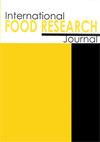将番木瓜叶提取物掺入玉米皮中用于糯米饭零食包装
IF 1
4区 农林科学
Q4 FOOD SCIENCE & TECHNOLOGY
引用次数: 0
摘要
本文对木瓜叶提取物(PLE)的效价进行了评价,以改善玉米壳作为糯米零食(GRS)包装材料的性能。总酚、单宁和皂苷含量分别为7.41±0.65 mgTAE/mL、1.80±0.70 mgTAE/mL和11.78±0.36 mgDE/mL。傅里叶变换红外光谱分析证实了GRS表面存在生物活性化合物。C=O的拉伸振动(1744 cm-1)以及C - O和C - C的振动(1051 cm-1)产生了皂苷的特征带。单宁在1051 cm-1处为C-O不对称拉伸振动,在926和866-867 cm-1处为C-H平面外振动。PLE的抗氧化活性为49.53±2.67%。总平板计数(TPC),酵母和霉菌计数(YMC)和黄曲霉- a的减少。24 h后,玉米皮上的寄生数在0.2 ~ 1.2 log CFU/cm2之间,贮藏14 d后,其寄生量保持在2 log CFU/cm2以下。通过对掺入PLE的玉米皮进行扫描电镜观察,结果表明,由于提取物颗粒粘附在玉米皮表面,PLE降低了玉米皮的水蒸气透过率。在不显著降低玉米皮抗拉强度的情况下,掺入PLE也提高了玉米皮的伸长率。TPC、YMC和黄曲霉a均有减少。添加le的玉米皮在贮藏期间的GRS寄生数在0.4 ~ 2.3 log CFU/g之间。添加了apple的玉米皮可以最大限度地减少GRS的酸败。由于其生物活性成分,将PLE掺入玉米皮中可以改善玉米皮的包装特性,控制玉米皮的微生物污染,延缓玉米皮的酸败。本文章由计算机程序翻译,如有差异,请以英文原文为准。
Incorporation of papaya (Carica papaya L.) leaf extract into cornhusk for glutinous rice snack packaging application
The present work was performed to evaluate the potency of papaya leaf extract (PLE) to improve the characteristics of cornhusk as a packaging material for glutinous rice snack (GRS). Total phenolic, tannin, and saponin contents of PLE were 7.41 ± 0.65 mgTAE/mL, 1.80 ± 0.70 mgTAE/mL, and 11.78 ± 0.36 mgDE/mL, respectively. The presence of bioactive compounds on the surface of GRS was confirmed by Fourier transform infrared spectroscopy analysis. Characteristic bands for saponin were caused by the stretching vibration of C=O (at 1744 cm-1) as well as C‒O and C‒C vibrations (at 1051 cm-1). Tannin was identified as C‒O asymmetric stretch vibration at 1051 cm-1 and C‒H out of plane vibration at 926 and 866-867 cm-1. The antioxidant activity of PLE was found to be 49.53 ± 2.67%. The reductions of total plate counts (TPC), yeast and mould counts (YMC), and Aspergillus flavus-A. parasiticus counts on PLE-incorporated cornhusks after 24 h were in the range of 0.2 - 1.2 log CFU/cm2, and retained the loads below 2 log CFU/cm2 during 14-d storage. PLE decreased the water vapour transmission rate of the cornhusk due to the particles of the extract adhering to the cornhusk surface, as supported by the result of the scanning electron microscopy of PLE-incorporated cornhusk. The incorporation of PLE also increased elongation without reducing the tensile strength of the cornhusk significantly. There were reductions of TPC, YMC, and Aspergillus flavus-A. parasiticus counts of GRS ranging from 0.4 - 2.3 log CFU/g using PLE-incorporated cornhusks during storage. GRS rancidity was minimised by PLE-incorporated cornhusks. Owing to its bioactive compound, PLE could be incorporated into the cornhusk to improve packaging characteristics and controls microbial contamination of GRS while retarding the rancidity.
求助全文
通过发布文献求助,成功后即可免费获取论文全文。
去求助
来源期刊

international food research journal
Agricultural and Biological Sciences-Food Science
CiteScore
1.40
自引率
0.00%
发文量
75
期刊介绍:
The International Food Research Journal (IFRJ) publishes papers in English, six (6) issues a year with the coverage of:
Food Science and Technology
Nutrition and Dietetics
Agriculture, multidisciplinary
Chemistry, multidisciplinary
The scope of the Journal includes:
Food Science, Food Technology and Food Biotechnology
Product Development and Sensory Evaluation
Food Habits, Nutrition, and Health
Food Safety and Quality
Food Chemistry, Food Microbiology, Food Analysis and Testing
Food Engineering
Food Packaging
Food Waste Management
Food Entrepreneur
Food Regulatory
Post-Harvest Food Management
Food Supply Chain Management
Halal Food and Management
 求助内容:
求助内容: 应助结果提醒方式:
应助结果提醒方式:


